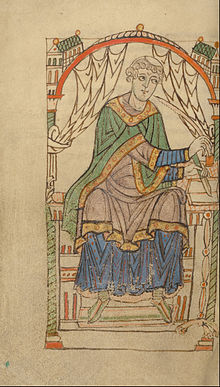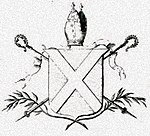Eadmer
 From Wikipedia the free encyclopedia
From Wikipedia the free encyclopedia

Eadmer or Edmer (c. 1060 – c. 1126)[1] was an English historian, theologian, and ecclesiastic. He is known for being a contemporary biographer of his archbishop and companion, Saint Anselm, in his Vita Anselmi,[2] and for his Historia novorum in Anglia, which presents the public face of Anselm. Eadmer's history is written to support the primacy of Canterbury over York, a central concern for Anselm.[3]
Life
[edit]Eadmer was born of Anglo-Saxon parentage, shortly before the Norman conquest of England in 1066. He became a monk in the Benedictine monastery of Christ Church, Canterbury, where he made the acquaintance of Anselm, at that time visiting England as abbot of the Abbey of Bec. The intimacy was renewed when Anselm became archbishop of Canterbury in 1093; afterward Eadmer was not only Anselm's disciple, but also his friend and director, being formally appointed to this position by Pope Urban II. In 1120 he was nominated to the bishopric of St. Andrews (Cell Rígmonaid), but as the Scots would not recognize the authority of the see of Canterbury he was never consecrated, and soon afterwards he resigned his claim to the bishopric.[4] His death is accepted as during or after 1126.[5]
Eadmer must also be credited with influencing the spread of the doctrine of the Immaculate Conception of the Blessed Virgin Mary in the West when he defended popular traditions in his De Conceptione sanctae Mariae. The origins of the dogma lay in the East and had been long-established in Greece. The idea began to gain currency in England in the opening decades of the 11th Century and had become the subject of liturgical veneration and a feast day (8 or 9 December) at Canterbury, Worcester and Winchester by about 1030. The feast had been discarded by Lanfranc in his reorganization of the liturgical calendar after the Conquest and Eadmer's advocacy of a sinless Mary was probably motivated as much by the restoration of local Anglo-Saxon devotions at Canterbury as with the wider propagation of the doctrine. The idea that Mary herself was born of a Virgin was not sanctioned by Rome and was considered by some to be a heresy. Whilst Eadmer argued that Christ's human perfection required that his Mother should be also without sin, Anselm held that by excluding any person from the taint of Original Sin destroyed the absolute necessity for the Incarnation. The fact that the doctrine spread throughout England and France throughout the Twelfth Century may have been largely, and ironically, due to the mis-attribution of Eadmer's De Conceptione Sanctae Mariae to Anselm's authorship.[6][7]
Works
[edit]Eadmer left a large number of writings, the most important of which is his Historia novorum in Anglia, a work which deals mainly with the history of England between 1066 and 1122. Although concerned principally with ecclesiastical affairs, the Historia, scholars agree, is one of the ablest and most valuable writings of its kind. It was first edited by John Selden in 1623 and, with Eadmer's Vita Anselmi, was edited by Martin Rule for the Rolls Series (London, 1884).[4] R. W. Southern re-edited Vita Anselmi in 1963 with a facing page translation, and Geoffrey Bosanquet translated the Rolls text of Historia Novorum in 1964.
The Vita Anselmi, written in about 1124, and first printed at Antwerp in 1551, is probably the best contemporary life of the saint. Less noteworthy are Eadmer's lives of St Dunstan, St Bregwine, archbishop of Canterbury, and St Oswald, archbishop of York.[8] The manuscripts of most of Eadmer's works are preserved in the Parker Library at Corpus Christi College, Cambridge.[4]
- Historia novorum, ed. M. Rule, Eadmeri Historia novorum in Anglia. Rolls Series 81. 1884.
- Vita S. Anselmi "Life of St Anselm" (c. 1124), ed. and tr. R.W. Southern, The life of St Anselm, archbishop of Canterbury. T. Nelson (New York), 1962. 2nd ed., Oxford University Press (Oxford), 1972.
- Vita S. Oswaldi "Life of St Oswald" and Miracula S. Oswaldi, ed. and tr. Bernard J. Muir and Andrew J. Turner, Eadmer of Canterbury. Lives and Miracles of Saints Oda, Dunstan, and Oswald. OMT. Oxford, 2006. 213-98 and 290–324; ed. J. Raine, Historians of the Church of York and its Archbishops. Rolls Series 71. 3 vols: vol 2. London, 1879. 1–40 and 41–59.
- Vita Wilfridi Episcopi "Life of Bishop Wilfrid", ed. J. Raine, Historians of the Church of York and its Archbishops. Rolls Series 71. 3 vols: vol 1. London, 1879. 161–226.
- Breviloquium Vitae Wilfridi, ed. J. Raine, Historians of the Church of York and its Archbishops. Rolls Series 71. 3 vols: vol 1. London, 1879. 227–37.
- Vita S. Odonis "Life of St Oda", Archbishop of Canterbury, ed. and tr. Bernard J. Muir and Andrew J. Turner, Eadmer of Canterbury. Lives and Miracles of Saints Oda, Dunstan, and Oswald. OMT. Oxford, 2006. 1–40.
- Vita S. Dunstani "Life of St Dunstan", Archbishop of Canterbury, and Miracula S. Dunstani, ed. and tr. Bernard J. Muir and Andrew J. Turner, Eadmer of Canterbury. Lives and Miracles of Saints Oda, Dunstan, and Oswald. OMT. Oxford, 2006. 41–159 and 160–212; ed. W. Stubbs, Memorials of St Dunstan, archbishop of Canterbury. Rolls Series 63. London, 1874. 162–249, 412–25.
- "Life of St Bregowine", Archbishop of Canterbury, ed. Henry Wharton, Anglia Sacra. London, 1691. 75–87 (where the Life is wrongly attributed to Osbern).
- Vita S. Audoeni "Life of St Audoen"
- Prayers and Meditations:[9]
I Consideratio Edmeri peccatoris et pauperis Dei de excellentia gloriosissimae Viginis Matris Dei.
II Scriptum Edmeri peccatoris ad commovendam super se misericordiam beati Petri ianitoris caelestis.
III Insipida quaedam divinae dispensationis consideratio ab Eadmero magno peccatore de beatissimo Gabriele archangelo.
IV De Conceptione Sanctae Mariae editum ab Eadmero monacho magno peccatore.
Notes
[edit]- ^ J. C. Rubenstein, ‘Eadmer of Canterbury (b. c.1060, d. in or after 1126)’, Oxford Dictionary of National Biography, Oxford University Press, 2004 accessed 8 Feb 2011
- ^ The standard work on Eadmer is R. W. Southern, Saint Anselm and His Biographer: A Study in Monastic Life and Thought, Cambridge, 1963.
- ^ C. Warren Hollister, Henry I (Yale English Monarchs) 2001:12f.
- ^ a b c Chisholm 1911.
- ^ Some older authorities gave earlier dates for his death; at page 291 of "Early Scottish Charters, Prior to 1153", Sir Archibald Campbell Lawrie (editor), Glasgow, 1910, Published by James Maclehose and Sons, Glasgow, 1905, it is stated that Eadmer died on 13 January 1123. Chisholm 1911 stated "[h]is death is generally assigned to the year 1124."
- ^ David Knowles, The Monastic Order in England (Cambridge, 1941), pp. 510-14.
- ^ Richard Southern, St Anselm: a Portrait in a Landscape (Cambridge, 1993), pp. 432-36
- ^ These were all printed in Henry Wharton's Anglia Sacra, part ii (1691), where a list of Eadmer's writings will be found.
- ^ A. Wilmart (ed.), 'Edmeri Cantuariensis cantoris nova opuscula de sanctorum veneratione et observatione' Revue des Sciences Religieuses Vol. 15 (1935)
References
[edit]- Geoffrey Bosanquet, Eadmer's History of Recent Events in England (London, 1964)
- Martin Rule, On Eadmer's Elaboration of the first four Books of "Historiae novorum" (1886)
- Philibert Ragey, Eadmer (Paris, 1892).
- R. W. Southern, Saint Anselm and His Biographer (Cambridge, 1963)
- This article incorporates text from a publication now in the public domain: Chisholm, Hugh, ed. (1911). "Eadmer". Encyclopædia Britannica. Vol. 8 (11th ed.). Cambridge University Press. p. 789.
- Herbermann, Charles, ed. (1913). . Catholic Encyclopedia. New York: Robert Appleton Company.
- . Dictionary of National Biography. London: Smith, Elder & Co. 1885–1900.
- Rubenstein, J. C. "Eadmer of Canterbury (b. c.1060, d. in or after 1126)". Oxford Dictionary of National Biography (online ed.). Oxford University Press. doi:10.1093/ref:odnb/8383. (Subscription or UK public library membership required.)
